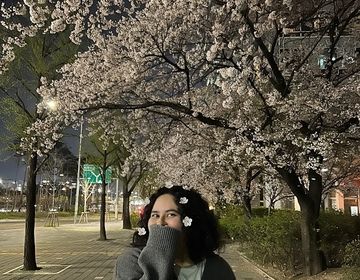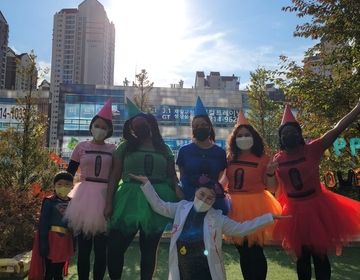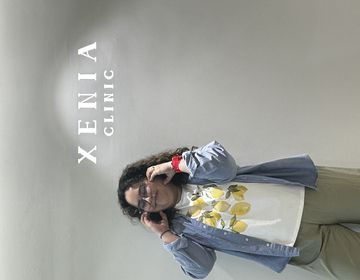What I Like About Living in Korea
I decided to take a picture of these fish . . . I was about to eat one of them, raw.
This is an abridged list of the things I admire and appreciate and enjoy about living in Korea. Some of these things I've thought about for a while, while others I simply thought of today. However it's difficult to think of every single thing I've loved in the past six-seven months, which is why this condensed list will suffice.
The people
are so friendly, courteous, and kind. My friend Yoon Gu and his wife Yong Soon have been kind enough to show me various traditional Korean villages, meeting more locals, and trying new Korean foods.
top: standing with Yoon Gu; bottom: standing with Yong Soon.
Public transportation
is a huge part of my life here as a foreigner, since I don’t have a car and don’t plan on getting one. Trains and buses have relatively low fares (aside from the KTX High Speed Train that goes to three major cities in Korea (Daegu, Pusan, and Seoul).
Work atmosphere
(at schools) is productive but yet easy-going. Teachers and administrators will sit, drink tea, eat snacks, munch on Tteok korean rice cakes and chit chat often during their break times. I hear “Evan, eat” many times when I enter the teacher’s lounge—someone summoning me to sit down and rest. It is not uncommon to see a teacher crack open a beer after school. Eating a big part of thework culture here; it helps maintain bonds, as does drinking.
Public helpers,
older men in subways, or older women, will ask if you need assistance. They aren’t dressed in uniforms. Some of them may not work for the government, but some of them do I’m sure. While most Koreans try to help others in general there are easy-to-read English signs that say “Please Ask for Help!” throughout the subways in Seoul and elsewhere.
Street Food
is a huge part of Korean culture in both rural and metropolitan areas. Koreans fry many things in tempura batter on rolling carts alongside the street. They skewer fried meat and shellfish on a stick. I love fried vegetable tempura, shrimp tempura, and old fashioned kebabs. Also street food, pa’jon ,are Korean grilled vegetable pancakes, but these do not come on a stick.
Clothes
here fit my size and style, literally. Korean men are slim like me, which is definitely not the case back in the States (affordable), and many times there are good bargains. I also like that Koreans both men and women suave and done-up. Some like brand names more than others but everyone here likes to look good. This is especially true in Seoul where plenty of Koreans look like they’re going to a board meeting. However, even in Yeongyang, my little mountain town, many Koreans dress nice, too, although far less than in bigger cities.
Korean snacks
are the best I’ve ever had (not candy, but snacks). Ace crackers are so good they have a holiday in Autumn called “Ace” day. It’s a marketing gimmick my previous coteacher told me, but on that day students and sometimes teachers have drawers and bags full of buttery Ace crackers. They are as buttery as Ritz crackers, if not more. I think they’re better. There are also chocolate and vanilla wafer sticks that are very addicting, chocolate covered cookies, Peppero chocolate covered cookie sticks (Peppero day), and shrimp flavored rice chips. If I want to digest something other than fruit or vegetables before or after dinner, I can choose from a wide array of snacks available at the grocer just around the corner.
Living costs
here are low. I’m able to save a good amount of my paycheck because the cost of living is much lower than in the States. Utilities are small. Bear in mind I’m living in the countryside. In Seoul or major cities, it is different.
Lodgings
can be cheap--but still high quality. Motels range from 30-60,000 won or about thirty to sixty bucks for decent sized single rooms for one night. This rate is higher in Seoul, but in Daegu, I paid 40,000 won for a huge room that to the plain eye was basically a suite.
Korean dishes
all come with Kimchi and rice. Some are spicy but usually not mouth-burning. Although I’m not a fan of kimchi here are a few of my favorite Korean dishes: Bibimbap, Yukwae, Gimbap, (Chinese-Korean) Bogeumbap, Beef and Pork Galbi (prefer beef), Jampong (very spicy broth, noodles and mussels, but I can’t eat it too often because of the spiceyness) and the list goes on...
Good health
is not a suggestion but a requirement of everyone. Whether its going to the local jimjibang to rejuvenate or to the local gym, everyone from teachers to retired ajosshis (older men) live healthy. Even more than youth, seniors in Korea often pass by younger people on hiking trails. I’ve heard plenty of stories where a group or couple of nanas have passed a young foreign English teacher. Watching seniors taking care of themselves is refreshing. There are outside workout corners dedicated to seniors—although people of all ages use them. Often older men and women will pass by me in a hurry on their bicycles.
History,
they are proud of their history, as they should be. They never let you forget it, either by conversation or in public monuments. National and city parks are scattered across Korea. Even in Yeongyang, in the county park, there is a Korean War Monument and other vestiges of history.
above: monument of a Korean being beaten. This is reminiscent of Japan's Forced Occupation--pre-Korean War--when countless Koreans were publicly beaten by the Japanese.
Server buttons
are attached to tables in many restaurants around Korea. All you have to do is push the button and a server comes to your table. Usually there is a light door-bell like sound that goes off when you press the button. Because Korean is a service-oriented country, service from waiters, to cars garages to home internet maintenance typically is quick and painless. -
Mural Art
in many places here, particularly in the city of Andong, where I’ve noticed them most (as its the city I’ve visited the most) are stories for curious eye. One special mural along a city wall features a “tug-of-war” scene between two groups of Korean children (the game is called something else here). I thought these murals were all painted by government employees or city workers, but the other day I saw a group of kids with an instructor painting a mural here in Yeongyang.
above: students painting a mural in Yeongyang.
Technology
can be seen everywhere. After all, this is the country that birthed the Samsung galaxy 4 to the smartphone lovers of the world. Plenty of taxis carry card scanners called T Money cards which hold money for buses and subways. Air and toothbrush sanitizers are common in schools. Huge 30-40 inch plasma televisions hang off the wall in every classroom. Many standard-grade Samsung, Hyundai and Kia cars come equipped with rear cameras and even heated seats. Because Korea is known for producing high quality brands like Samsung, one can rest assured that things not only work, but they work well.
Beauty
is one word I would describe Korea. Sights from Seoul to the Southern tip of Korea exist for many people to see and most of Korea is tucked between or alongside mountains--even the big cities. This makes Korea refreshing, especially so during long bus rides across the country.
above: traditional Korean village near Andong
Yours truly,
Evan
Related Posts
A Comprehensive Budgeting Guide for English Teachers in South Korea
A Comprehensive Budgeting Guide for English Teachers in South Korea Teaching English in South Korea has become an increasingly popular option for young people looking to travel and get some... keep reading
Professionalism in South Korea as a Native English Teacher
As a native English teacher in South Korea, understanding Korean culture and professionalism is crucial for both personal success and the broader impact you can have on your students. South... keep reading
How to Go to the Doctor in South Korea as an English Teacher: A Guide to Healthcare and Health Insurance
As an English teacher in South Korea, maintaining good health is essential while living abroad. Navigating the healthcare system can seem daunting and stressful at first, especially if you can’t... keep reading


